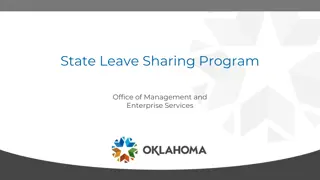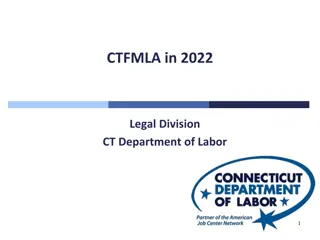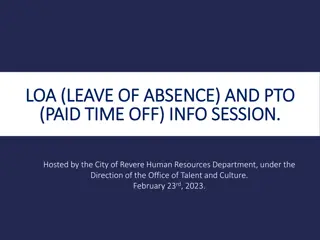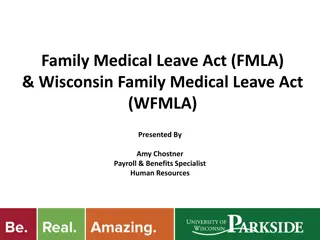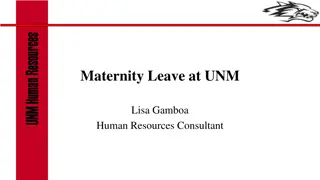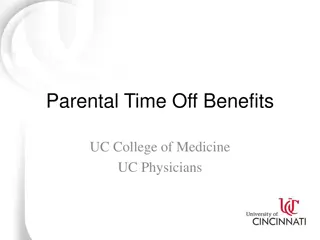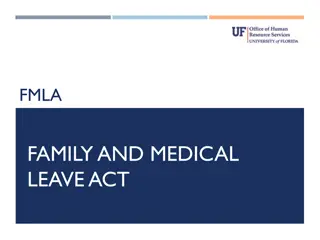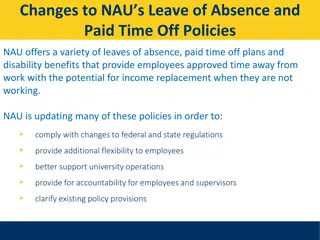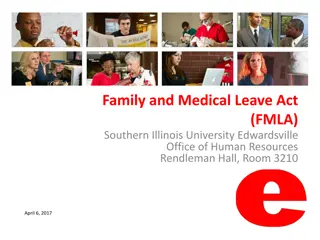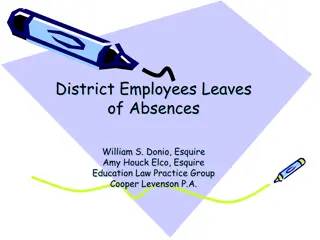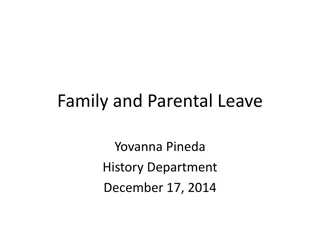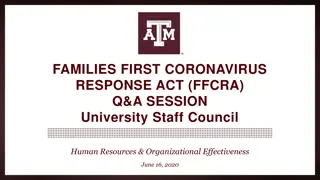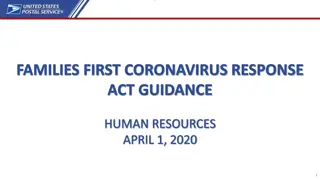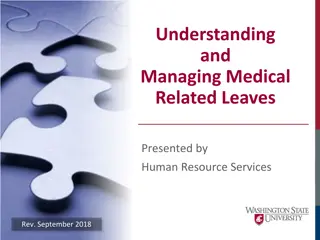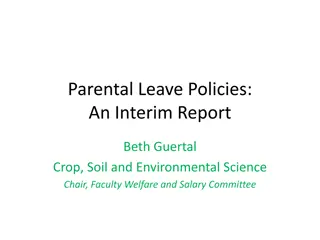Understanding the Family and Medical Leave Act (FMLA)
The Family and Medical Leave Act (FMLA) allows eligible employees to take unpaid leave for up to 12 weeks for specific family and medical reasons. The FMLA aims to promote work-life balance, economic security, and family integrity. This act was signed into law by President Bill Clinton in 1993 and has seen expansions in coverage, including provisions for military caregiver leave and same-sex partnerships. Employers must provide notices and adhere to specific requirements for employees seeking FMLA leave entitlement.
Download Presentation

Please find below an Image/Link to download the presentation.
The content on the website is provided AS IS for your information and personal use only. It may not be sold, licensed, or shared on other websites without obtaining consent from the author. Download presentation by click this link. If you encounter any issues during the download, it is possible that the publisher has removed the file from their server.
E N D
Presentation Transcript
Introduction to the FMLA Purpose: Balance work and family life Promote economic security of families Preserve family integrity President Bill Clinton signed the Family and Medical Leave Act of 1993 two weeks into his first term as president The National Defense Authorization Act for Fiscal Year 2010 was signed by President Barack Obama on October of 2009 to expand the availability of military caregiver leave and qualifying exigency leave In 2015 the definition of spouse was expanded to include same-sex partners and common-law marriages- no matter what state the employee lives in
Providing Notice Posting Requirement- posters explaining: The FMLA provisions How to file a complaint Must provide each employee with a general notice about the FMLA in the employee handbook or other written materials about leave and benefits. If no handbook or written leave materials exist, the employer must distribute this general notice to each new employee upon hire. This general notice requirement can be met by either duplicating the general notice language found on Labor s FMLA Poster and may be distributed electronically provided all the requirements are met.
Family and Medical Leave Act Unpaid time off from work (12 or 26 weeks). State employees can choose to use: Vacation leave Compensatory time Sick leave (If the condition for using sick leave meets the sick leave criteria in the Labor Contracts and/or Rules) Employee must have at least 12 total months of service and at least 1250 hours (actual work hours) of service in the previous twelve month period to be eligible. Temporary employment counts toward an employee s eligibility. A minimum of 30 days notice to the Agency must be provided by the employee before he/she may use FMLA Leave. Where 30 days notice is not foreseeable, notice must be given as early as possible. Employer must respond to the FMLA Request IN WRITING within 5 business days
Leave Entitlement Must grant an eligible employee up to a total of 12 workweeks of FMLA leave during any 12-month period for one or more of the following reasons: for the birth and care of a newborn child of the employee; for placement with the employee of a son or daughter for adoption or foster care; to care for a spouse, son, daughter, or parent with a serious health condition; to take medical leave when the employee is unable to work because of a serious health condition; and for qualifying exigencies that arise when the employee s spouse, son, daughter, or parent is on covered active duty or has been notified of an impending call or order to covered active duty. (used to manage family affairs)
Leave Entitlement (continued) Military Caregiver Leave: Eligible employees may take up to 26 workweeks of leave in a single 12-month period to care for a covered servicemember with a serious injury or illness if the employee is the spouse, son, daughter, parent, or next of kin of the servicemember. An eligible employee is limited to a combined total of 26 workweeks of leave for any FMLA-qualifying reasons during the single 12-month period.
Immediate Family Members Spouse means a husband or wife as defined or recognized in the state where the individual was married, including in a common law marriage or same-sex marriage. Spouse also includes a husband or wife in a marriage that was validly entered into outside of the United States, if the marriage could have been entered into in at least one state. Parent means a biological, adoptive, step or foster father or mother, or any other individual who stood in loco parentis to the employee when the employee was a child. This term does not include parents-in-law. An individual stands in loco parentis to a child if he or she has day- to-day responsibilities to care for or financially support the child. The person standing in loco parentis is not required to have a biological or legal relationship with the child. The in loco parentis relationship exists when an individual intends to take on the role of a parent.
Immediate Family Members Son or daughter means a biological, adopted, or foster child, a stepchild, a legal ward, or a child of a person standing in loco parentis, who is under 18 years of age or who is 18 years of age or older and incapable of self-care because of a mental or physical disability at the time that FMLA leave is to commence. The onset of a disability may occur at any age for purposes of the definition of an adult son or daughter under the FMLA. Next of Kin (for Servicemember s Medical Leave only) means the servicemember s nearest blood relative, other than the servicemember s spouse, parent, son or daughter in the following order of priority: designated blood relative (in writing), blood relatives with legal custody, brothers and sisters, grandparents, aunts and uncles, first cousins.
Covered Servicemember Includes: A Current Servicemember of the Armed Forces, including a member of the U. S. National Guard or Reserves, who is undergoing medical treatment, recuperation, or therapy, is otherwise in outpatient status, or is otherwise on the temporary disability retired list, for a serious injury or illness; or A Veteran who is undergoing medical treatment, recuperation, or therapy for a serious injury or illness, and who was discharged within the previous five years before the employee takes military caregiver leave to care for the veteran.
Serious Health Condition Illness, injury, impairment, or physical or mental condition that involves either: Inpatient care or subsequent treatment in connection with such inpatient care; or Continuing treatment by a health care provider, this includes: A period of incapacity lasting more than three consecutive, full calendar days, and any subsequent treatment or period of incapacity relating to the same condition; or Any period of incapacity related to pregnancy or for prenatal care; or
Serious Health Condition (continued) Any period of incapacity or treatment for a chronic serious health condition which continues over an extended period of time, requires periodic visits to a health care provider, and may involve occasional episodes of incapacity; or A period of incapacity that is permanent or long-term due to a condition for which treatment may not be effective; or Any absences to receive multiple treatments for restorative surgery or for a condition that would likely result in a period of incapacity of more than three days if not treated.
Serious Health Condition (continued) A serious injury or illness for a current servicemember is an injury or illness that was incurred by the servicemember in the line of duty on active duty that may render the servicemember medically unfit to perform the duties of his or her office, grade, rank, or rating. A serious injury or illness may also result from the aggravation of a pre-existing condition in the line of duty on active duty. A serious injury or illness for a veteran is an injury or illness that was incurred in the line of duty when the veteran was on active duty in the Armed Forces, including any injury or illness that resulted from the aggravation of a preexisting condition in the line of duty on active duty. The injury or illness may manifest itself during active duty or may develop after the servicemember becomes a veteran.
12 Month Period (Leave Year) Employee Family Medical Leave Calendar Year (January 1st December 31st) Fixed 12 months (e.g. fiscal year) 12 months measured forward from the first date that an employee takes FMLA Leave. (The State of Nebraska currently practices this method.) Rolling 12 month look back from the date an employee uses FMLA Leave. For Family Military Leave the 12 month period measures forward from the first date. An eligible employee is limited to a combined 26 workweeks (can include both Family Medical and Military Leave)
12Month Look Forward Example An eligible employee requests four weeks of FMLA leave to begin on November 1, 2017. The employer looks forward 12 months (from November 1st forward to the next October 31st) and keeps track as the employee uses two weeks of FMLA leave beginning January 1st, four weeks beginning March 1st, and two weeks beginning May 1st. The employee has taken 12 weeks of FMLA leave in the 12-month period. Anytime after November 1, 2018 the year would begin again and the employee would be eligible for more FMLA leave.
Military Family Leave An eligible employee requests four weeks of Military FMLA leave to care for a qualified servicemember to begin on November 1st. The employer looks forward 12 months (from November 1st forward to the next October 31st) and keeps track as the employee uses eight more weeks of Military FMLA leave beginning January 1st, four weeks of FMLA for their own serious medical condition beginning March 1st, and three weeks of Military FMLA beginning May 1st. The employee has taken 15 weeks of Military FMLA and 4 weeks of FMLA leave (19 weeks combined) in the 12-month period. They would still be eligible for up to 7 more weeks of FMLA or 7 more weeks of Military FMLA in this 12 month period. (Total number of weeks cannot exceed 26 weeks in the 12 month timeframe.)
Intermittent FMLA Leave Under some circumstances, employees may take FMLA leave intermittently, or on a reduced leave schedule. When leave is needed for planned medical treatment, the employee must make a reasonable effort to schedule treatment so as not to unduly disrupt the employer s operation. If FMLA leave is for birth and care, or placement for adoption or foster care, use of intermittent leave is subject to the employer's approval. Under certain conditions, employees or employers may choose to substitute (run concurrently) accrued paid leave (such as sick or vacation leave) to cover some or all of the FMLA leave.
Health Insurance Employer health insurance contributions shall continue during an employee s unpaid FMLA Leave absence, provided the employee makes his/her required contribution and intends to return to work for at least 30 days following his/her FMLA leave. Employer contributions shall be based as if the employee had continued to work his/her normal schedule.
Health Insurance At such time that an employee is in an unprotected LWOP status (FMLA has ended and the employee does not have any leave accruals), he/she will have health insurance/pharmacy benefits terminated after 14 consecutive days in the unprotected LWOP status. Any paid medical or pharmacy claims incurred during the unprotected LWOP status will be the responsibility of the employee and the State may seek to recover all funds expended by the State on behalf of the employee during this period of ineligibility. The employee will be offered COBRA coverage in accordance with federal law.
Health Insurance (continued) When an employee does not return from FMLA Leave the employee will be required to reimburse the State for the State's share of health insurance premiums paid on the employee's behalf during the FMLA Leave. Unless: the continuation, recurrence, or onset of a serious health condition which would entitle the employee to FMLA Leave; or other circumstances beyond the employee's control
Can I Contact the Doctor? An employer s HR administrator, leave administrator, or management official (but not the direct supervisor) may directly contact an employee s health care provider to clarify and authenticate the certification after giving the employee an opportunity to cure any deficiencies in the medical certification While the employee is out on FMLA, it is also the employer s right to expect the employee to provide any updated information and respond to supervisor/HR requests for updated information
Recertification If the minimum duration of the period of incapacity specified on a certification furnished by the health care provider is more than 30 days, the employer may not request recertification until that minimum duration has passed. For FMLA taken intermittently or on a reduced leave schedule basis, the employer may not request recertification in less than the minimum period specified on the certification as necessary for such leave (including treatment) unless one of the following conditions are met: The employee requests an extension of leave; Circumstances described by the previous certification have changed significantly; or The employer receives information that casts doubt upon the continuing validity of the certification.
Return to Work/Fitness-for-Duty For an employee s own serious health condition, employers may require certification that the employee is able to resume work Employer must have a uniformly-applied policy or practice of requiring fitness-for-duty certification for all similarly-situated employees If state or local law or collective bargaining agreement is in place, it governs the return to work Employee responsible for any cost
Return to Work/Fitness-for-Duty Not permitted for intermittent or reduced schedule leave unless reasonable safety concerns exist Employer (not the supervisor) can seek authentication (the information was completed and/or authorized by the health care provider ) and clarification (understand handwriting or meaning of a response) before returning the employee to work
Job Restoration Same or equivalent job equivalent pay equivalent benefits equivalent terms and conditions Employee has no greater right to reinstatement than had the employee continued to work (example- layoffs, performance improvement plans, discipline, etc.)
Prohibited Employment Actions Employers cannot: interfere with, restrain or deny employees FMLA rights discriminate or retaliate against an employee for having exercised FMLA rights discharge or in any other way discriminate against an employee because of involvement in any proceeding related to FMLA use the taking of FMLA leave as a negative factor in employment actions
Group Activity What do you know about the FMLA?
Joe has requested Family Medical Leave. His girlfriend is pregnant. They do not live together but he wants to take time off to help take care of the newborn. Can you approve Joe s FMLA request? Why or Why not? Scenario #1
Cindy has requested three weeks of FMLA leave to take care of her common-law husband. They have been living together for 10 years and he needs to have surgery on one of his shoulders. Do you grant her request? Why or Why not? Scenario #2
Susie has been diagnosed with Multiple Sclerosis. Her doctor has given the prognosis, based on her current symptoms, that the MS will advance quickly and begin to affect her mobility first, followed by her vision. Susie has applied for FMLA and has requested to not use all twelve weeks at one time. She would prefer to use the leave depending upon her condition on a day to day basis. Do you approve her leave? Why or Why not? Scenario #3
Marcus requests FMLA in order to take care of his wife and children. His wife is a stay at home mom and she previously served in Afghanistan in 2015. Her left leg was amputated after she was injured by a road-side bomb. She is no longer on active duty, but she needs to have surgery to remove some infected tissue on her thigh and will also need physical therapy to adjust to her new prosthetic. The couple has three children under the age of five. Marcus is requesting 12 weeks off, during the months of April, May and June, and asks if he would be able to take more time off in the fall. Do you approve his request? Why or Why not? Scenario #4
Melanies husband has broken his collar bone. He fell while he was re-painting the house over the weekend. He is an active member of the Army Reserves and Melanie has requested 26 weeks of leave under the military provision of the FMLA. Do you grant her the 26 weeks that she s requested? Why or Why not? Scenario #5
Greg broke a hip and was out on paid sick leave for three months with surgery, therapy, and recuperation (1-1-17 through 3-31-17). Two weeks after returning to work Greg had a heart attack and was out on paid sick leave having heart surgery and recuperating for two months (4-16-17 through 6-15-17). Greg ran out of sick leave on 6-15-17, and requested FMLA for 12 weeks after 6-15-17, which would take him thru 9-7-17. Greg s Dr. completed the FMLA Physician s Certification, and it was legitimate that Greg needed the additional 12 weeks of time off before returning to work. Does Greg get to use the FMLA? Why or Why not? Scenario #6
Questions? Employee Relations at (402) 471-4106 (402) 471-8292 (402) 471-4104 Employee Relations Website: www.das.nebraska.gov/emprel/




